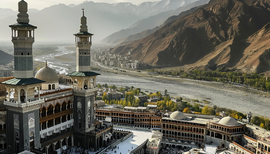Holy State of The Hodhat
Holy State of The Hodhat | |
|---|---|
 Panorama of the sacred valley and Sahadar | |
| Country | |
| Capital | Sahadar |
| Government | |
| • Type | Theocracy |
| • Body | Divine Council |
| • Custodian | TBA |
| • Civil Governor | TBA |
| Population (2021) | |
| • Total | 181,229 |
The Holy State of the Hodhat is a Sayanic community of priests, known as kharmyani in Goh Ochimsuk, and holds the status of an autonomous region with exclusive clerical and judicial rights. Comprising the Hodhat, enclaves, and historical settlements, it is revered as the most sacred site in Zarasaism. Although geographically isolated and with an actual population of 181,000, the Hodhat remarkably receives around 2 million pilgrims annually during the month of A-Huyil.
The Holy State is named after the Hodhat, the most sacred site in Zarasaism, meaning high country in Kalkali. This area was primarily inhabited by pre-Vaniuan peoples until the 2nd century when Vaniuan, eastern Mirarian, and Rartakan peoples expanded into the region. The name 'Hodhat' is a calque of a now-lost term used by pre-Vaniuan Tahavi pilgrims during their journeys to the high peaks.
The Holy State comprises 48 monasteries from various denominations, inhabited solely by priests of diverse nationalities. These include prominent denominations like Desarism, Shawadiism, and Qasamism, among others, with a few belonging to minor religious groups. All monasteries date back to at least the 7th century and house well-preserved artefacts of great religious significance, rare manuscripts, books, artworks, and historical documents that predate the monasteries.
To this day, Sahadar remains the only continuously inhabited settlement by civil servants of the Heavenly Kingdom and those providing accommodation to pilgrims. The Holy State enforces strict rules on accommodation permits and the duration of stay, typically limited to four months. Additionally, the city is notable for a significant holy site, Zarasa's Shrine, which is the first prayer stop for pilgrims before they proceed to the Hodhat.
The Holy State is accessible only via the Goh Ochimsuk railway line, departing directly from the capital to Sahadar. Entry on foot is prohibited, except with prior permission from the Divine Council. The Holy State forbids entry to minors under 15 and bans alcohol or products deemed sacrilegious. Additionally, it exercises a "right of enforcement" over pilgrims who violate holy laws, including enforcing a strict dress code on its lands, and punishments where deemed justified.
The region is the only sovereign entity in Vaniua considered a theocracy, where the law strictly abides by the Holy Yecadan and all judicial scriptures, making it the only autonomous state with such exclusive rights.

